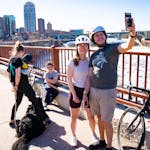As the world watched the civil rights uprising in Minneapolis after George Floyd's death, some in the city were not surprised that it happened here. They had seen it before.
In July 1967, people angered by suspected police brutality took to the street on Plymouth Avenue, then one of the city's commercial strips. Three nights of arson and destruction drew hundreds of National Guard troops and added Minneapolis to the list of cities in the mid-1960s rocked by protests.
In the eyes of two activists of that era, Minnesota is still in denial about its own issues with systemic racism.
Lifelong civil rights advocate Josie Johnson was an adviser to the mayor at the time, and hopes that the city's pain in 2020 will lead to real change.
"It was a hurtful moment to see this man murdered and yet I felt that perhaps his sacrifice would enlighten the world as to how our Black men can be treated without any worry on the part of the authority," Johnson said. "I had the feeling that perhaps George Floyd's life had a historical and lasting help in the world seeing how Black men in America can be treated."
The state's unwillingness to confront racism and inequities is why "Minnesota is the Mississippi of the north," said Spike Moss, who, helped co-found The Way, a Black community center on Plymouth Avenue, in 1966.
"It's never just the incident that sparks it," Moss said. "The fuse is always there, we just need you to light it. We go to bed and we wake up in the same hell."
The spark on July 19, 1967, was the rough handling by Minneapolis police of two Black girls who were fighting over a wig, the Star Tribune reported at the time.
"The police were not gentle, but you can't be in separating two women," police Inspector Donald Dwyer said then.
Police said Black youths set fires and threw rocks at law enforcement and shop windows of north Minneapolis businesses, most of them Jewish-owned at the time. Thirteen Black people were arrested after the first night of disturbances.
Black people were protesting in the street over more than just their grievances of police violence but lack of access to jobs, housing and other injustices based on the color of their skin, Johnson said.
During the 1967 protests, Johnson was an adviser to Mayor Arthur Naftalin and was urging him to understand why the Black community was rebelling.
She said Naftalin had a "deeper sense" than other mayors seeing disruption in their cities at that time on why there was anger and unrest in the Black community, even if Minneapolis wasn't perceived as having the same problems with race as Detroit or Newark, N.J.
"We were viewed as a different collection of people, and we too in Minnesota are having serious racial and equality issues and therefore there was a need to pay attention to that," Johnson said.
"We too needed to say that Black people in Minnesota are upset and angry and felt that denial of justice and equality too and we could identify what our brothers and sisters in other parts of the U.S. felt."
Moss said part of the reason Minnesota's problems on racism and discrimination were not more widely known at the time was because of the lack of local media coverage — including the Star Tribune's predecessors — and suppression of stories about how Black people and Native Americans were being discriminated against and brutalized.
He said The Way was unfairly blamed in the media for stoking trouble. It became harder for the center to secure funding after that.
After Floyd's death in May, he felt as if "finally" there was tangible evidence of the brutality the Black community had long spoken of and no one could deny it.
Rose Brewer, a professor of African American and African studies at the University of Minnesota, pointed out that while the 1967 uprising and the Floyd protests happened in different political and social moments, there's "certainly continuity" in what the Black community is fighting for.
Another difference is that Minnesota's inequalities were exposed during the Floyd protests in a way that had more reach than the 1967 protests. There was a "convergence of crises" with the coronavirus pandemic, people losing jobs, lack of access to health care and more, Brewer said.
"You have a whole period of instability and the fact that that police narrative has always been embedded in what catalyzes the Black community to respond," Brewer said. "It's just been so consistent over so long of a period of time I would say it should not be surprising to folks to make that connection between an earlier period that did catalyze a lot of what we are confronting today."
For Johnson, Floyd's death shows "the struggle is probably more evident" for how hard it's been to not only seek justice but force Minnesotans to see how the police can treat Black people.
As horrified as she is by what happened to Floyd, she is heartened that this time feels different.
"Everything dealing with humans and policies has a time that finally is understood, is seen, is heard and it's when those times come that people are able to respond," Johnson said. "Minnesota's time finally came when people could actually associate the disadvantaged inequality and abuse of our people everywhere and acknowledge that, yes, we too need to be conscious of that and work on it."
Marissa Evans • 612-673-4280






